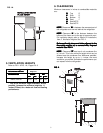
12
7) Reassemble the components in the reverse order to
that described for removal, taking care to remake the
gas connections soundly, and not forgetting to refit the
flue baffle.
8) Reinstall the refrigerator in its recess. Connect the gas
and electrical supplies, and check for gas leaks. Light
the burner and check the appearance of the flame to
ensure that it is predominantly blue (when the thermo-
stat is at "HIGH"), then leave the refrigerator on "test"
for at least an hour.
3. TROUBLESHOOTING
If the refrigerator fails to work, check the following points
before calling a service technician:
A. Instructions for STARTING THE REFRIGERATOR,
Section C, have been followed.
B. The refrigerator is level.
C. If it is possible to start the refrigerator on any of the
connected sources of energy.
D. If the refrigerator fails to work on GAS, check:
1) That the gas bottle is not empty.
2) That all LP Gas valves in the supply line to the
refrigerator are open.
NOTE: The following checks should be performed
only by a qualified technician.
3) That sparks are generated by the piezo ignitor.
4) That the flame continues to burn after releasing the
knob of the flame failure device (B, in FIG. 8). If not,
the thermocouple may be loose or defective.
E. If the refrigerator fails to work DC, check:
1) That the DC supply is connected to the refrigerator.
2) That the fuse on the DC supply is intact.
3) That the DC switch is set to the "ON" position (A, in
FIG. 8).
F. If the refrigerator fails to work on AC, check:
1) That the AC supply is connected to the refrigerator.
2) That the fuse on the AC supply is intact.
3) That the AC switch is set to the "ON" position.
4) That the AC thermostat is not set to the "0" position.
G. If the refrigerator is not cold enough it may be because:
1) The ventilation is inadequate owing to reduced area
of the ventilation passages (partial blockage of
grilles from wire mesh, etc.).
2) The evaporator is frosted up.
3) The temperature control setting is incorrect.
4) The gas pressure is incorrect. Check the pressure
regulator.
5) The ambient temperature is too high.
6) Too much warm food is loaded at one time.
7) The door is not properly closed or the magnetic
sealing strip is defective.
All of the previous instructions are to be followed closely. This refrigerator is
quality guaranteed; however, we are not responsible for any failures caused
by improper adjustments and unfavorable installation conditions. If assis-
tance is required, contact the service point or distributor service department.














